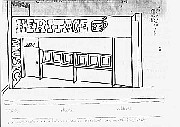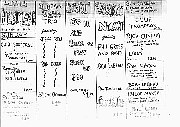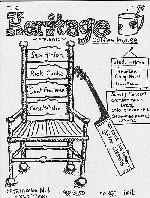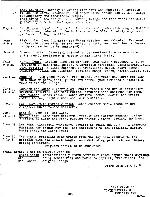The Heritage Coffeehouse
"I think I made more as a doorman than I did playing.
Eight dollars a night on the door, six dollars a night on stage...
A little strange..."
After attending Hilltop High School in Chula Vista (1968), Waits held a number of jobs around town. One was as the doorman at the now-defunct San Diego Heritage Coffeehouse. The Heritage was in Mission Beach at 3842 Mission Blvd. That's on the Ocean side in just about the narrowest part of N. Mission.
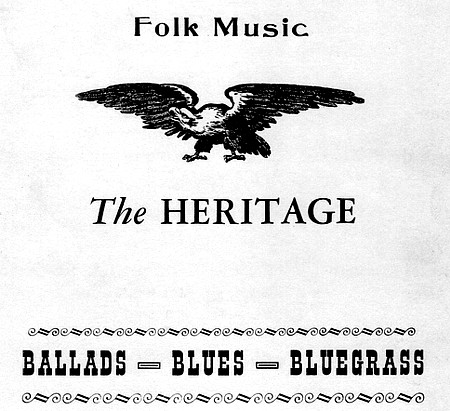
The Heritage logo as pictured on a late 1960's menu (as previously shown on Steve Lutes MySpace)
The Heritage Coffeehouse was actually never mentioned in an official bio press release, but Waits did mention the place during some early gigs he did in 1973/ 1975. Some articles wrongly locate the Heritage in Los Angeles and others have it confused with Napoleone Pizza House. Young Tom Waits worked at Napoleone when he was still in high school. This was probably before The Heritage gig. It might be however Waits played at the Heritage while still working at Napoleone. In retrospect one can see Waits going through three interesting stages here. The first being Napoleone Pizza House where young Tom got fascinated with music and started writing down people's conversations. The second stage being The Heritage where Waits started developing a stage persona and where he tried his first smart talking streetwise routines. And the third stage being The Troubadour, where Waits went for a professional music career and where he had already found his own particular niche.
Tom Waits (1975): "I dropped out of high school, I worked at restaurants, I was a bartender, I worked as a firefighter for a while, I drove delivery trucks in town and worked at a jewelry store and several gas stations, washed dishes, I was a janitor, a cook, I just took all the odd jobs everybody takes odd jobs when you're just kicking around, ended up I was taking tickets on the door at a coffee house in Mission Beach and I was the official bouncer. I got bounced every now and then. You get these big, obstinate conventioneers that come down to the Beach to go slumming and they come elbowing their way through. They gave me like the leg of a chair to defend myself with. Slowly I worked up to where I was doing a weekend now and then and I was playing a little guitar, a little piano, doing Mississippi John Hurt songs and Reverend Gary Davis and it was basically a traditional club with the emphasis on stringbands, banjo, fiddle, bluegrass folk music, traditional blues, very few songwriters. I was just one of many and it was kind of a beach community musical school where people come and hang out, just local talent, no big thing."(14)
Tom Waits (1996): "My musical education began at a small folk club - the Heritage, ... which is now [1975] just nothing but a memory, a small club in San Diego which had a lot of traditional music, a lot of country artists, bluegrass, that sort of thing. I soaked it in like a sponge. I sat on the door and I listened to as much as I possibly could."(4) "I listened to all kinds of music there. All kinds of stuff from rock to jazz to folk to anything else that happened to walk in. One night I saw a local guy onstage playing his own material. I don't know why, but at that moment I knew that I wanted to live or die on the strength of my own music. I finally played a gig there. Then I started writing down people's conversations as they sat around the bar. When I put them together I found some music hiding in there."(3) "I was about 19, and [Ramblin' Jack Elliott's] record was one of the most-played at this little coffee house. Jack's record was on the turntable all the time, the one where he's on the cover with his horse and he's roping something. It had '912 Greens' on there, spoken out, the song that so moved me. It had his version of 'Tennessee Stud' and some Woody Guthrie songs." ... "(5)
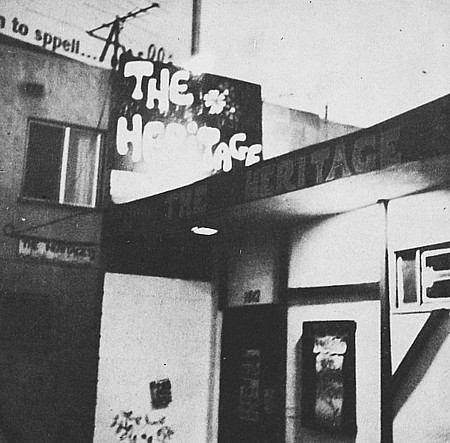
The Heritage front door in 1968. Unknown source dated sept. 13, 1968.
Tom Waits (1974): "Right before Bob Labeau took over and I was coming down and hootin'. I started with Bobby Dylan songs. Was singing a lot like that, but I wasn't writing anything. I was trying to learn some more tunes, more traditional vein, to be able to sit in at the Heritage a little better because it didn't seem as though songwriting was in vogue at the time. I was doing Mississippi John Hurt and that sort of thing. The first weekend I had at the Heritage it was Bob LeBeau and Tom Waits and we split the bill a couple of times after that. It was Bob Webb, at first, who gave me a weekend there. I'd been hootin' for quite a while and I had a girlfriend who got a job waiting tables too. So she was kind of putting a good word in for me with Bob and finally he came around and said, "We'll risk it." And I was the doorman and that was one of the important steps for me because I got to listen every weekend. It was one place you could run into someone you haven't seen in three of four years and that was usually the place you went when you got back in town to see who was in town. All those people that used to hang out there. When the Heritage closed it was hard for a long time to even make contact with them and now you can make contact with them at Folk Arts. Some of those nights at the Heritage were just as enterteining as what was going on inside. There was like two shows. There was the people that would come down at night, wouldn't even go inside sometimes."(15)
Some believe Waits being a doorman for the Heritage was just another story made up. John Gazlay, who became acquainted with Waits when he played at The Heritage himself, confirms Waits did not only play the club but also was a doorman for some time. This would have been from 1969 onwards. Lou Curtiss, who has known Waits since he was in high school, remembers Waits coming in about 1968. Dave Robinson remembers Waits hooting at the Heritage in 1971.
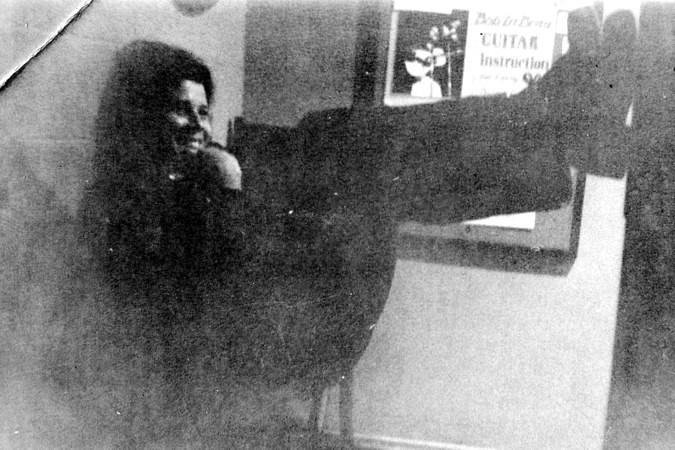
Waits sitting on the door at the San Diego Heritage. Date: 1970.
Credits: Cathy Nickols-Nagao (as previously shown on Steve Lutes MySpace)
Lou Curtiss (2002):(2) "I guess I've known Tom since he was in high school & I knew The Heritage for most of its existence. About 1963 to 1972. The original owner and owner for most of its existence was Bill Nunn. Bill played dobro & liked most kinds of traditional song. He had a partner in the beginning but they opened a second place (a bar) called the White Whale about a mile north of The Heritage called Bird Rock. It wasn't long after that that the other guy took the WW & Bill assumed full ownership of The Heritage. The Heritage was always a class place. For the years "The End" (another coffee house on Grand Ave. in Pacific Beach) was open (1963 to 1967) there was kind of a rivalry between the two places because they were less than a mile apart. In the time The Heritage was open I saw lots of variety of music there ranging from Mississippi Bluesman Big Joe Williams & Sam Chatman, to singer songwriters like Mary McCaslin, bluegrassers like Chris Hillman and The Gosdin Bros. Bill Nunn sold The Heritage to Bob Webb in about 1970 and Bob Webb sold it to a guy who owned another coffee house called "In The Alley" in about 1972 and both places went out of business shortly thereafter."
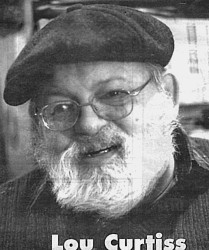
Lou Curtiss (Source: San Diego Troubadour. April, 2003. Vol. 2, No. 7)
Tom Waits (1973):(7) "I played around San Diego quite a bit for a couple of years while there were clubs still open down there - it's very difficult to find a place to play now. Folk Arts - Lou Curtiss still has that outfit going on weekends, I used to play at The Heritage, it's closed now, they turned it into a spiritual book store or something. Bob Webb(6) owned it and I used to sit on the door, I used to hoot down there and then I gave that up and I said I'll sit on the door, made 5.00 a night and then I started doing a weekend occasionally. Jack Tempchin(8) was playing around the area at the time."
|
Artists listed on right flier (ca. 1972): Curt Bouterse, Beautiful Elizabeth & Bob LaBeau, San Diego String Quartet, Stream Jazz trio featuring Jeff Rew & Ron Odgen & Steve O'Connor, Phil Gross and band, Bob LaBeau, Guy Carawan, Julie Thompson, Rick Cunnha & Linda, Sam Hinton & Bob LaBeau, Chloe Marsh & Phil Gross
|
|
|
Both fliers kindly provided by Lou Curtiss. September, 2002. |
|
Lou Curtiss (2006):(16) "It was during those late evenings after the Heritage coffeehouse closed and we'd put away the instruments that Waits, Ray Bierl, and I would wander down Mission Blvd. a block or so to Saska's Steakhouse for one of their steakburgers, coffee, and some conversation. It was often about music (that's what we all did on one level or another), but we also talked about other things. Like how Tom's Monday night pilgrimages to L.A. were going at the Troubadour Club Hoot where he showed off his wares so that he could get some kind of a record deal, or maybe we'd talk about a new song or a book one of us read, always accompanied by a joke or two. We always had a good time. Our get togethers lasted just a couple of years until Tom moved on. The music is still good but what I remember is the conversation and the burgers. Saska's is still there but the conversations are only echoes."
Lou Curtiss (2007):(20) "The first times I saw him play I thought, 'He's just another Dylan guy'. The first song of his own I ever remember him doing was called 'Poncho's Lament'. I was standing next to Bill Nunn and I said, 'That's a good song, He's got promise."
TOM WAITS AT THE HERITAGE(13)
By Bob Webb
The following material copyright C2003 Robert Lloyd Webb, used by permission at www.tomwaitslibrary.com. No portion may be copied to another website or reprinted by any means manual or electronic without permission of the copyright holder.
Few coffee houses in the United States survived as long as The Heritage in San Diego, California. In the 1960s Bill Nunn rented a modern cinder-block, one-storey structure at 3842 Mission Boulevard in the Mission Beach district and established The Heritage as a venue for "traditional" singers. The entrance faced east on Mission Boulevard, a wide north-south avenue that continues the length of a sand-spit peninsula separating the Pacific Ocean from Mission Bay. The district includes the entire peninsula from Pacific Beach in the north, and consisted of the businesses that fronted the boulevard, and a geometric maze of narrow side streets, barely wider than alleyways, which were filled with small cottages that originally served as summer retreats for people who lived and worked away from the shore. The area is much the same today, except that its shoreside location has driven the residences "upscale" - many have been expanded almost to their lot boundaries and raised into two-storey and even taller structures.
By 1970 Mission Beach was a "counter-culture" neighborhood, much like fabled Haight-Ashbury in San Francisco. Almost all the cottages were rented, most for very little money. Mission Boulevard became a haven for hippies, bikers, drug-addicts and other socially-disenfranchised young people. It was an ideal location for a folk-music club, since the "underground" reputation of Mission Beach attracted patronage from nearby colleges, the posh district of La Jolla, and the extensive facilities of the U. S. Navy in San Diego.
Today, the building that housed The Heritage is used as a street bar. The front wall has been removed, and the interior is open to view by drivers and pedestrians who pass by. In The Heritage days, however, guests paid admission at the front door, then walked a narrow corridor across the front of the building behind the cinder-block facade, entering the performance room by way of an interior doorway at the north end of the building. There was one large room with chairs and tables, and a stage at the southeast corner. A partial wall near the back of the room created a gallery space where artists exhibited their work, and in an adjacent small kitchen the staff prepared and served non-alcoholic drinks, many of the most popular made with Mexican chocolate carried across the border from Tijuana. A side door opened into the alley from the gallery space. At the very back of the building, a narrow "back room" provided performers with a modest semi-private space in which to prepare themselves.
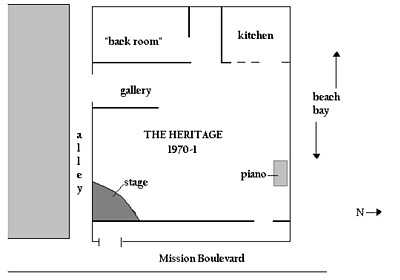
The club was open every week from Wednesday through Sunday. The format included open-mic "hoot" nights (short for "hootenanny") on Wednesdays and Sundays. On Thursday nights one of the regular club performers hosted an evening of music with guests of his own choosing. Both Bob LaBeau and Ray Bierl hosted Thursday evenings during the last two years the club operated. Friday and Saturday evening acts were booked well in advance, advertised, and paid.
|
Artists listed (ca. 1972): Sam Hinton, Rick Cunha, Curt Bouterse, Mary McCaslin, Chloe & Bob LaBeau.
|
Artists listed (May-June, 1972): Mary McCaslin, Phil Gross, Sam Hinton, Rick Cunha, Joseph Trotter, Martin Henry, Curt Bouterse, Home #3, Carlson and Durio, Larry Blom, Roy Swanson, San Diego State String Quartet, Bob LaBeau, Lee Ryan, Ted Staak, Chloe Marsh.
|
|
Both fliers kindly provided by Phil Gross/ Dave Robinson. May, 2003. |
|
TOM WAITS AT THE HERITAGE(13)
By Bob Webb
The following material copyright C2003 Robert Lloyd Webb, used by permission at www.tomwaitslibrary.com. No portion may be copied to another website or reprinted by any means manual or electronic without permission of the copyright holder.
From March 1968 I began performing at The Heritage, driving 200 miles round-trip from my home in Culver City. For me and for many others, Bill Nunn's club became a "home from home," where we met musicians and singers who shared common artistic interests. Many were "traditional" or "folk" performers, presenting what is now known as roots music. Others were nascent singer-songwriters. Then, in the winter of 1969-70, I agreed to assume operation of The Heritage, as Bill was anxious to go jade mining in the Big Sur, south of San Francisco.
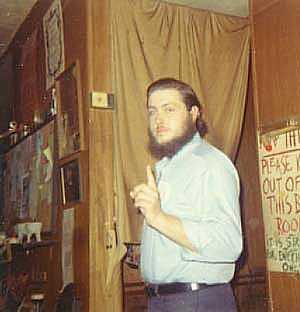
Bob Webb by the back room at The Heritage, 1971. Wes Alderson Photo
Tom Waits arrived at the club shortly after I bought it, at first singing the house maximum of two songs at the "hoot" nights. Among all the beginning and intermediate-level performers, he showed the most remarkable sense of "stage-presence": well do I remember his interpretation of the Elvis Presley hit "Are You Lonesome Tonight," in which a vocal chorus hummed the melody while Presley delivered a spoken monologue. Showing stage gifts beyond his age, Tom cajoled the audience to provide the melody so that he could recite the monologue - not an easy task in the United States, where people are disinclined to sing in public, particularly when leaderless.
He began to look for more connection with The Heritage, so I asked if he would be willing to serve as a "relief" doorman, selling tickets and hawking on the sidewalk whenever my regular doorman had to be absent. He "worked the door" several times during the following months. But it was also clear that he had a larger "draw" than many performers who played at The Heritage. I decided to book him as an opening act for a weekend, but only reluctantly, because I was philosophically committed to presenting "traditional" music - ballad-singers, bluesmen, string bands and the like. Tom certainly was not traditional, either in his choice of music or his performance style. He was already performing his own material, compositions like "Ol' '55" and "Diamonds on My Windshield," songs that would appear on his first solo album, Closing Time. The rest of his repertoire included covers of popular folk/ country hits like "Big Joe and Phantom 309," and various Elvis numbers.
He had too much charisma to ignore. People just about begged me to hire him, and when I did they readily paid admission to hear him and watch him perform. Before long, he and I established a friendship, based on our mutual interest in Beat literature, pocket billiards (pool), car culture, the "underground" life of the night and, in particular, the poetry and prose of author Jack Kerouac, who was a major influence on both of us.
Lou Curtiss (2002):(2) "My wife Virginia & I played at The Heritage with a variety of groups from about 1966 on and did a couple of stints running the Hoot Night (open mike). I first remember Tom coming in about 1968 while Bill still owned the place and it quickly became his place to hang. When Bob took over the place Tom became the doorman and it was also about that time that he started making those Monday night treks up to L.A. to "The Troubadour" where he was eventually heard and signed by Asylum records"

Virginia and Lou Curtiss. Early 1970's.
Phil Gross (1974):(12) "The Heritage, I don't know when it started, but it had been going for almost ten years. It kept changing hands. I was only involved with it the last year it was open. It was a small club in the Beach area. The whole area was a resort. A lot of people who came to listen were from the Beach itself Then the drug culture took over MB [Mission Beach - TWL]... and it died out."
Jack Tempchin (2007):(19) "The Heritage was like a little theater. If somebody was performing and you talked to the person next to you, the waitress would come over and say there was no talking, and if you talked more they just kicked you out."
Lou Curtiss (2002):(2) "I opened my shop Folk Arts Rare Records in 1967 and when The Heritage closed I started concerts in the store and vowed to do them until another coffee house of the same quality opened. That was in March of 1972 and I did them until July of 1977. Tom did 4 or 5 of them for me. The only ones I can date are Nov 11, 1973 and Jan 11, 1974. In the spring of 1967 I produced the 1st San Diego Folk Festival and did that every spring for the next 20 years. Tom played the 1974 festival... Along with The Heritage I'm pretty sure Tom also played at In The Alley (in Escondido), The Candy Company (in East San Diego) and The Bifrost Bridge (in La Mesa). I know he played at The Back Door at San Diego State Univ., and probably at the Univ. of California at San Diego's on campus coffee house (it's called Che's Cafe today but I think it had another name (equally radical sounding) back then."
Lou Curtiss (2007) on Waits being the doorman:(20) "Sometimes it was more fun standing outside gabbing with Tom than being inside the place. He was great to talk to. He was reading everything he could get a hold of. He'd have books by Kierkegaard. He was getting into some pretty heavy philosophy along with Kerouac and all that stuff"
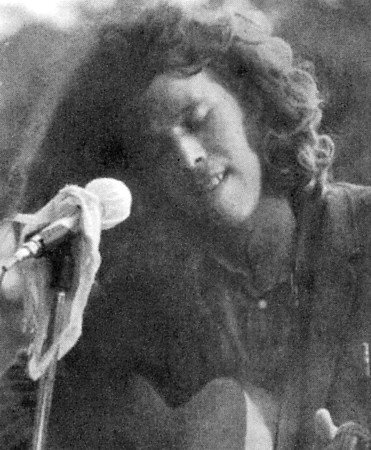
Waits on stage at The Heritage, ca. 1972/ 1973 (as printed in “Lowside Of The Road: A Life Of Tom Waits"
by Barney Hoskyns. Faber/ Broadway, 2009). Credits: photography by Bobi Thomas
Bobi Thomas (2006):(17) "Tom Waits and I went to the same High school (Hilltop High in Chula Vista, California). My first memory of Tom is seeing him walk (actually it was more of a free-wheeling strut) down the open-air hallways at Hilltop High. I remember thinking at the time "that man has music in him" partly because of the free-and-easy way he walked (and the way his shoulders swayed from side-to-side, his shoes clicking down the walk-way). A friend of mine named David took me down to The Heritage folk club while I was still a Junior in High School (about 1968), and as soon as I found that club I was hooked on the music and the general "feeling" of the club. David and I would go down to the club once or twice a month and sip our alcohol-free drinks (all sorts of coffee drinks and all sorts of cider drinks) and just bask in the music. It wasn't long before my friend David talked me into signing up for one of the "Hoot Nights" which was a lot like a "jam night".All you had to do was to find the "Hootmaster" in charge for that evening and say "I'd like to play tonight" and, if there was still space available on the list, they would sign you up. I remember that Pam Ostergren was in charge of the Hoot the first night I played.I think at that time Bob La Beau was running the other Hoot Night, but thru the years quite a few different people took turns hosting the Hoots (Grady Tuck, Curt Bouterse and a host of others), so I could be wrong about that. Anyway, I remember my fingers shook so much during my song(s) that I could hardly play. I think my voice shook too, I was so scared! Pam was very sweet and kind to me when I got off stage, possibly because I was the newest, youngest kid on the scene. I remember that she told me I needed to come back soon and sing again, and I remember that she told me she had LIKED ME!!! That was all I needed! It wasn't long before I was talking my mom and dad into letting me hang out at the club on the weekends, and once I got a drivers license I was allowed to go out to the Wednesday Hoots too!!! IT WAS HEAVEN FOR ME. A few years later Pam Ostergren and I began to sing together on the road as "Pam Ostergren & Bobi Thomas". We played places like The Ark in Ann Arbor, Izzy Young's Folk Lore Center in NY, Philidelphia Folk Lore Center and a bunch of other clubs in and around the Eastern Sea Board."
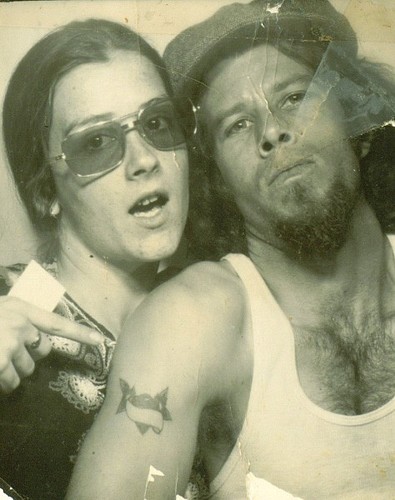
With Bobi Thomas (ca. 1973/ 1974).
Source: Bobi Thomas official site, 2006 (kind permission Bobi Thomas)
John Gazlay (2002):(1) "I met Tom Waits for the first time in the summer of 1971 at The Heritage. He was actually doing some funny imitations of Elvis in his act. I remember I liked an instrumental he did on piano named "Sinatra". I met up with him a few years later when he had already released albums on Asylum. He needed to borrow my acoustic guitar for a gig at San Diego State University. His had become broken at the airlines... I was a singer songwriter at the time I was acquainted with Tom Waits in San Diego at The Heritage. I had hitchhiked down there from Washington state. I was engaged in numerous conversations with him, sometimes going down just to chat with him outside and not go in. We hit it off pretty good."
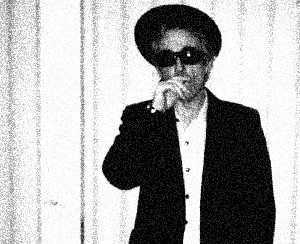
John Gazlay. Poopah Music, 2002
TOM WAITS AT THE HERITAGE(13)
By Bob Webb
The following material copyright C2003 Robert Lloyd Webb, used by permission at www.tomwaitslibrary.com. No portion may be copied to another website or reprinted by any means manual or electronic without permission of the copyright holder.
Tom's first paid appearance on The Heritage stage - I believe his first paid gig anywhere - took place during 20-21 November 1970.(1) He appeared as "Thomas Waits" and opened the show for a duet called "Michael Claire," featuring English folk-pop singer Michael Milner and his American partner (later wife) Claire Hart. On 22 November Tom signed the cash book "Thomas Waits" and received $25.00 for his appearance.(2) He continued to sing occasionally at "hoot" nights, and also appeared as Bob LaBeau's guests on some Thursday nights. His second weekend booking began on New Year's Day evening, 1-2 January 1971.(3) He again appeared as "Thomas Waits" and opened for LaBeau and a third act called "Ostergren & Thomas," which was the guitar/ banjo/ singing duet of Pami Ostergren and Bobi Thomas. Tom received $18.00 for the two nights of work.
It's important to say that his pay, though little, was typical of what one could expect to be paid for a two-night gig in a folk-music coffee house anywhere on the American west coast. Folk clubs in the eastern part of the country paid considerably more.
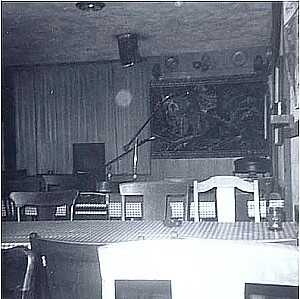
The Heritage stage as it appeared 22 February 1970. The entry doorway may be seen to the left of the hanging curtains, at the very left margin of the photograph.
A fair bit of advance work became necessary whenever Tom was booked. On "hoot nights" he played a flat-top steel-stringed guitar, but he began to rely more heavily on the piano to present his own songs, and we didn't have one. A few blocks up Mission Boulevard, down another alley leading to the beach, Tom had a close friend who owned a large upright piano, which we agreed in a mercurial moment to borrow for his use. This required hoisting the instrument out of her cottage onto a wheeled dolly, then shoving and pulling it awkwardly down alleys and walkways that seemed to be made more of sand than pavement. The dolly repeatedly became stuck, and when we finally reached the side door of The Heritage, we had to physically lift the piano down into the club, which was slightly below grade. Then we had to again get the dolly under it so we could move it into position along the north wall of the room. We decided not to put it on the stage, fearing that the supporting structure might collapse under its weight. Then someone had to climb a ladder to redirect some of the stage lights toward the piano. Tom sang and played guitar from the stage, and moved through the audience to the piano whenever he wanted to use it.
Tom next performed at The Heritage during a special program on 10 February 1971, which we billed as the "Happy Birthday Mary and Full Moon Concert."(4) He was a featured performer among several. Mary, by the way, was one of the favorite waitresses, and a long-time employee. Two days later he opened a weekend engagement (12-13 February 1971) for the banjo-player Brian Steeger.(5) There is no record of his pay for these February appearances, because I left the club seriously ill just before 10 February, and my manager paid performers, without asking them to sign the cash book, until 11 March.
Notes:
(1) Girl Scouts of the USA, 1970 calendar, November. This calendar was used at The Heritage as the official record of forthcoming programs.
(2) All cited accounts of payments to Tom Waits at The Heritage between 22-23 May 1970 and 25-26 June 1971 are recorded in a spiral notebook signed by performers to acknowledge receipt of payment.
(3) Girl Scouts of the USA 1970 calendar, December.
(4) "Happy Birthday Mary and Full Moon Concert," advertising handbill, February [1971].
(5) "February at the Heritage," advertising handbill, February [1971].
Bobi Thomas (2006):(17) "I remember seeing Tom Waits at the Heritage for the first time about a year after I started coming to the club, so that would have been around 1969 or so. He was clean-shaven at the time, and he had kind of longish hair (about to his collar or a little below) and he was usually wearing a slouch-hat and a suit-coat (with patches on the elbows) and jeans (straight-legged jeans). He also usually wore black pointed-toe shoes (which he thought were very hip). Tom started like all the rest of us, playing the Hoots on Wednesdays and Sundays. That boy did have music in him!! In the beginning Tom was playing other people's music, but it wasn't long before he began to sing us his own songs, and MAN, did we like it! There was an old upright piano in the club, and sometimes in the afternoon Tom would be in the club, plinking on that old piano. Sounded pretty good to me! A lot has been written about Tom being the door man at the Heritage, and he did do that sometimes, but in the beginning Steve Von Lutz was the only door man. Steve would sit outside and noodle on his guitar in-between taking money from us musician/ customers. Steve was a very talented musician, his "favorite" music was blues, I believe, and that's what I remember most about him. He eventually moved away, or quit working at the Heritage, I'm not sure if any one knows where he went, but he was one of those "astringent" people - if he was in a bad mood he could really "zing" you - which, probably because I was such a pest, he often did to ME!!! Steve Von Lutz he would play at the Heritage sometimes too, I think just about everybody who actually worked at the club also played on stage fairly often, either with another musician sharing the bill, or by themselves, depending on their "draw". Cathy Nichols was the "kitchen lady" when I first started coming down to the Heritage. She and I still keep in touch to this day. A lovely lady. Cathy got together with another singer whose name I have forgotten and they sang some at the Heritage too. As time went on I remember working in the Kitchen to help Cathy out sometimes, and once, when Cathy went to China to study and teach I took over her position. We all did whatever we could in those days to pay the rent, and to help out at the club."
Ray Bierl (2007):(18) "I met Tom in San Diego when he started showing up at open mikes, 'hoots', at the Heritage Coffee House in Mission Beach, playing his own and other people's songs. I remember him doing 'It Looks Like I'm Up Shit Creek Again'-- I got him to write down the words for me -- and Elvis' 'Are You Lonesome Tonight' complete with recitation. He hadn't taken up the piano at that point, but already had a strong personal style and a flair for performing and an integrity about him that audiences responded to. Tom soon was working as doorman at the Heritage, and on slow nights it seemed he had a bigger crowd hanging out with him on the sidewalk than were inside listening to the music. A small group of us used to close some of the local bars after closing time at the Heritage. We'd be telling the same jokes night after night and digging them more each time. It was a happening little scene for a bunch of us, and I remember it fondly. Tom and I played on stage a few times together, more for fun than for 'future'. It was clear he was heading in his own direction."
Dave Robinson (2003):(9) "I'm not sure that Tom ever headlined at that club. But he was there almost every night. Wednesday nights was an open mic hoot night, and he would almost always play a song or two. Thursday nights for about a year (as far as I can remember it would have been in 1971-72) was Phil Gross and Friends night. We would share the stage with one other local folk act, usually a singer-songwriter in the Bob Dylan mold. Tom was the doorman for the club, and he would occasionally get up between sets and play one or two songs. The Phil Gross band would also play at least once a month on the weekends opening up for out-of-town acts. I played electric and acoustic lead guitar and a bit of mandolin for Phil, and we had a bass player named Don (can't remember his last name). We did several original songs of Phil's, as well as covers from Jackson Browne, Fred Neill, Bob Dylan, Gene Clark, Gram Parsons, as well as songs by other local writers like Mark Montijo and Jack Tempchin."
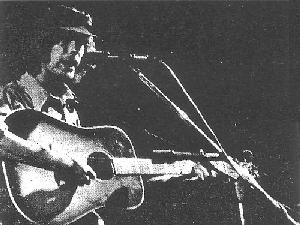
Phil Gross at the 1974 Backdoor's hoot night
(Source: 'Cheap talent giving a 'hoot'. Daily Aztec. September 20, 1974)
Phil Gross (1974):(12) "The closest now to national prominence is Tom Waits. Two or three years ago, he'd play at The Heritage, a Mission Beach club, now closed. Tom's got two new albums out. I first met him at the Back Door when it first opened in about 1968. He was Bob Dylan. He had the corduroy hat, the speech inflections of Dylan, a harmonica, all the mannerisms. After that, I didn't see him for a long time. Then, he was the doorman at the Heritage. He used to play there almost every week, but I never heard him. And then he went off to L.A. and disappeared. He came back, got an album out, and finally, last year, I went to see him and really enjoyed him... think he's a fine writer. He's one of my favorite people in general. Hopefully, if he gets the right breaks and a little advertising, he'll become a big seller from San Diego... be sorta nice."
Dave Robinson (2003):(9) "I remember once coming in to the club early to set up for the night's performance.Tom was sitting at the Heritage's ancient piano reading from a sheet of music some tin-pan alley song from the 30's or '40's. It could have been Gershwin or Cole Porter, but to me back then, it just seemed kind of funny that a guy in a folk club would be interested in anything so far outside of the usual folk category. I hadn't known that Tom could even read music, let alone play rudimentary piano."
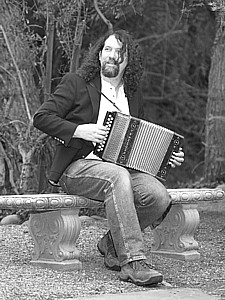
Dave Robinson, 2003. Photography by Merle Ledford III
John Gazlay (2002):(1) "He was a rag tag type of young fellow as was I. He was not a drunk. I also played in The Heritage during my stay in San Diego of about 7 months... Tom Waits at that time played a combination of "cover" songs and originals. He played more acoustic guitar than piano. Also, he sometimes ended his set with the old Roy Rogers/Dale Evans song "Happy Trails". I remember him doing some Dylan covers at the time and also an Arlo Guthrie song I think. Tom Waits had more of a folk style early on, like the mellow stuff on his Closing Time. The stage presence was there, hair all messy and sticking up, baggy old clothes, not a hippy look at all, but no boozy act either. But he was good on stage early, a natural. Kind of a cross between Dylan and A. Guthrie in presence. That's what I thought at the time. Wore like blue jeans and logger type boots. I remember talking to him the first time outside while he was at the door on a stool when he asked me what songs I did. I told him I only did originals, which was true. He said, 'Yeah, I agree, if you ever want to get anywhere you can't be singing other people's songs all night.'
Dave Robinson (2003):(9) "Tom got to be pretty good friends with another guy who hung out at the Heritage and eventually worked there as a dishwasher or cook. I don't remember his name, but he had long curly red hair (not unlike the comedian Carrot Top). One night he was talking to me and mid-sentence he flopped onto the floor, out cold. I was scared to death, but Tom walked calmly over and told me to just leave him alone and he would be OK in a couple of minutes. It turned out the guy was an epileptic and Tom had dealt with many of his seizures."
John Gazlay (2002):(1) "Jack Tempchin was also around at the coffeehouse at this time, the later well known songwriter that The Eagles used for some hits. He and Waits were friends and had a mutual respect and I've heard remained friends after each had become known artists. At the time I thought Tom Waits was one of the 2 best unknown singer songwriters I'd run into in my travels. The other being folk singer Jim Page of Seattle."
Dave Robinson (2003):(9) "I remember seeing Tom Waits and Jack Tempchin performing together at the Back Door singing a song they had written together called something like (I Got Drunk on the Way Home From) "Tijuana. In the Alley was a club where folk acts with national reputations would perform (Tim Buckley in his Starsailor phase, Eric Anderson, Tim Rose, The Dilliards, Doug Kershaw, Rambling Jack Elliot, and so on). One year on New Year's Eve, In the Alley had a local folkie marathon, about 6 hours of local performers doing set after set. The floor of the club was covered by throw pillows, and I have a distinct memory of hearing Tom do one of his new songs (that I thought was pretty awful) while reclining on one of those big pillows. It was called something like "Hey, Mr. Bullfrog," and it reminded me of something you'd hear on Sesame Street."
Bob Webb (2007):(21) "Almost all the local musicians were on the make. They were scrounging for any sort of thing - a gig, a drink, a lay, or a joint. Tom wasn't like that. He was polite, a little self-effacing, and in some real sense professional. I don't remember him having vices of the ordinary kind, though I suppose he smoked cigarettes. I never saw him do drugs, and he drank only moderately"
TOM WAITS AT THE HERITAGE(13)
By Bob Webb
The following material copyright C2003 Robert Lloyd Webb, used by permission at www.tomwaitslibrary.com. No portion may be copied to another website or reprinted by any means manual or electronic without permission of the copyright holder.
Tom accepted two more bookings at The Heritage while I owned it. During 2-3 April 1971 he opened for Mary McCaslin(6), who went on to have her own successful career as a singer and guitarist. He signed the cash book "Thomas A. Waits" and received $28.00. His final appearance for me was on the weekend of 21-22 May 1971. For the first time, he headlined the show. Bob LaBeau agreed to perform the opening set.(7) But top-billing didn't affect his pay: the cash book shows that "Thomas A. Waits" received $25.00, actually less than he was paid in April.
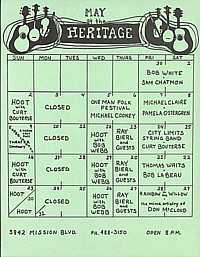
The Heritage handbill advertising Tom Waits's first featured-act performance, 21-22 May 1971.
(click picture for larger version)
The following month, June 1971, I sold my interest in The Heritage. Attendance had failed to generate enough revenue to pay outstanding obligations. To some extent the general audience had begun to drift away from traditional and folk music, but it is also true that Mission Beach had begun a rapid deterioration toward drug-dealing, gangs, and street violence. The larger community no longer felt completely safe at night on Mission Boulevard.
Within twelve months, The Heritage closed for good.
Notes:
(6) "April at the Heritage," advertising handbill, April [1971].
(7) "May at the Heritage," advertising handbill, May [1971].
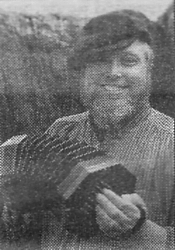
Bob Webb (Source: San Diego Troubadour. April, 2003. Vol. 2, No. 7)
John Gazlay (2002):(1) "I'm happy to let you know of my early experiences with Tom Waits. Here is a man who made it against all odds. An artist who refused to abandon his true style in favor of something more commercially appealing. I believe he is a true original and am most happy for his successes."
Lou Curtiss (2002):(2) "You know I think it was Toms storytelling ability that attracted me to him first. We'd stand out in front of The Heritage, Tom & fellow musicians Ray, Wayne Stromberg, Tom Presley, sometimes Bob LaBeau or we'd go down to Saska's Steakhouse for a burger & beer after The Heritage closed and sit and talk, swap stories, bullshit about people, politics, etc. til the early morning hours or until they chased us out. That boy could talk with the best of them and that's probably what I miss the most... I've still got the tape of that "Dirty Joke Workshop" he took part in with his buddy & fellow musician Ray Bierl."
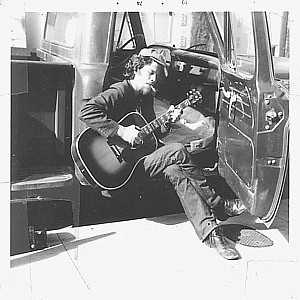
Tom Waits in front of San Diego Folk Arts, ca. 1973/ 1974.
Scan kindly donated to Tom Waits Library. Photography by Virginia Curtiss
Dave Robinson (2003):(9) I remember one of the few times seeing Tom do an extended set of more than 20 minutes or so. It might have been one of the Thursday nights and he finally got to share the night with Phil as co-headliner (not too sure of that). Anyway, Tom mostly did covers of well-known folk writers such as Dylan. He wore a harmonica holder around his neck like Dylan and would change harmonicas between songs. But he never once played the harmonica. He would talk between songs, and he was pretty funny, but his expression would remain completely dead-pan. I thought it was hilarious, but I'm not sure whether many other people got the joke about the harmonicas that never got played. The music he played was a bit dull.He wasn't much of a guitar player or much of a singer. But he did do a killer Elvis impersonation that came as a shock - again completely deadpan."(10)
Bobi Thomas (2006):(17) "Tom began going up to play at the Troubadour in Los Angeles, they had Hoot Nights there too! I seem to remember that he'd take the bus up there sometimes, and at other times times he'd drive depending on whether he had transportation. Tom eventually (within that first year) caught the eye of Herb Cohen, who signed him up and later got him signed to the Asylum label. After Pam and I stopped playing music together I moved up to Los Angeles.Tom let me stay in his apartment until I got a job working at the Copper Penny on the corner of Gower and Sunset Blvd. I finally saved enough money to move out and got my own place. He and I hung around for several years together in those early years, before the music took him away to other places. Being Tom's best friend during all those years has provided me with many, many sweet memories. He even wrote a song for me (Please Call Me Baby). How sweet is THAT!!! When he was on the road during those early years, he would write me long lonely letters. I still have them (tucked away in a safe place). None of those memories will ever die, you know, they'll always be tucked away in the recesses of my silly brain, waiting to surface when I hear the sounds of "San Diego Serenade" or "Shiver Me Timbers" or any of the other instantly identifiable Tom Waits Songs."
Further reading:
Steve Lutes MySpace
Ray Bierl official site
Grady Tuck MySpace Memorial
John Gazlay official site
Jack Tempchin official site
Bobi Thomas official site
Notes:
(1) Email conversations with John Gazlay: June - July, 2002. John Gazlay played at The Troubadour, McCabes, The Ice House and other clubs in the L.A. area in his early years. In his late 20's he became seriously alcoholic and disappeared into skid row. Periodically John would quit drinking and write more music but then once again would fall back into the grips. John has now overcome this obsession and has been sober for 6 years. He is writing better than ever in his blues rooted style. John has a solo CD out called "Gutter Flight" (Poopah Music, 2002). For further reading please check out the excellent Official John Gazlay site. John can be contacted at: gypsyjoey1@yahoo.com
(2) Letter from Lou Curtiss to Tom Waits Library: September 16, 2002. Lou Curtiss grew up in Imperial Beach south of Chula Vista & The Strand right next to the border and got out of high school in 1957, about ten years ahead of Tom Waits. In 1976 he opened his famous Folk Arts Rare Records shop and when The Heritage closed he started concerts in the store. Five years later he started The Adams Ave Roots Festivals and took over the booking for the ten year old Adams Ave Street Fair. Curtiss will be doing Street Fair number 21 in 2002 and in 2002 he will be doing the 30th Roots Festival.Lou is curator of the Lou Curtiss Sound Library, a 90,000 hour archive of vintage sound recordings dating back to the 1890's (with special emphasis on the 1920's, 30's, 40's and 50's. Further reading: Lou and Virginia Curtiss at the Adams Avenue Street fair, Lou Curtiss at KSDS-FM
(3) Source: "Smelling Like A Brewery, Lookin' Like A Tramp". Rolling Stone, by David McGee. January, 1977.
(4) Source: "Folkscene Interview 1975", with Howard and Roz Larman (KPFK-FM 90.7) Los Angeles/ USA. January 12 (February 13?), 1975.
(5) Source: "On The Road". San Francisco Examiner. Edvins Beitiks. August 4 1996.
(6) Bob Webb (Robert L. Webb) bassist/ guitarist and former owner of the Heritage. Webb and Waits were close friends around this time. The two also did some gigs together in 1973. Bob Webb went as a bassist on Waits' first 2 tours. Intro to "Ice Cream Man" (November 10, 1973. KCRW Snap Sessions. Santa Monica/ USA). TW: "I'm just gonna do a couple more, and then I want Bob Webb to come out and join me in a couple of closing tunes. So let me do this, and then... I think Bob is back there somewhere. [Bob: "I'm right here"] There he is!" After "Ice Cream Man" they play "Big Joe And Phantom 309" together. Intro to "The Heart Of Saturday Night" (November 10, 1973. KCRW Snap Sessions. Santa Monica/ USA). TW: "I'd like to end with this... Bob and I are driving around on Alvarado Street one afternoon [aside to Bob Webb] Remember? And eh, that's when I had this '58 Super, and eh, real low to the ground. It's kind of eh... Well the colour was kind of... well monkey-shit-brown I guess you'd call it." Bob Webb released "From Salthouse Dock" (1995) and "Bank Trollers" (RWA 0206, 2000).
(7) Source: "Folkscene interview 1973", with Howard and Roz Larman (KPFK-FM 90.7) Los Angeles/ USA. August 12, 1973.
(8) Jack Tempchin. writer/ singer/ guitarist. Longtime friends during the late 60's/ early 70's. Check out this Tempchin site for more information. They did a gig together for the KCRW-FM Snap Sessions, Santa Monica, November 10, 1973. "TW: Jack, you wanna come up and do that... song? [off-mike confusion over the title of the thing]. JT: I don't know... TW: Eh... maybe... You got me in a spot there! I don't know. JT: Tijuana... Sun? TW: Tijuana... eh... Tijuana! We'll just call it 'Tijuana'!"
(9) Email conversations with Dave Robinson: March 2003. David Michael Robinson played electric and acoustic lead guitar and mandolin with the Phil Gross band. Dave later switched to bass when he and Phil Gross continued as a duo for a couple of years. They opened for Waits at The Back Door in San Diego (October 19, 1975). They were also invited to Waits' debut at the Troubadour (opening for Little Feat. Early 1975). Nowadays Dave resides in California as a college English instructor.
(10) Dave Robinson: "According to Phil Gross Tom apparently stole that routine from Hamilton Camp (the writer of "Pride of Man" the song that Quicksilver Messenger Service recorded on their first LP). Hamilton Camp was a veteran folk singer from the early 1960s, who Tom might have seen at the Heritage or at one of the other folk clubs in town." Email conversations with Dave Robinson: March 2003.
(11) Dave Robinson: "Listed on the weekend on this particular calendar is Rick Cunha, who the calendar further identifies as a guy who played for Mason Williams. Mason Williams was huge in the late '60's with his recording of "Classical Gas." Mason also was one of the writers for the Smothers Brothers comedy show, and he got Rick a job playing guitar for the Smothers Brothers. They later recorded one of Rick's songs, "The Yo-yo Man," which became a kind of novelty semi-hit in the mid-1970s. A few years before (about 1968), Rick was in a pioneering country-folk group in L.A. called Hearts and Flowers. The Collector's Choice label just released a 2 disk compilation called "The Complete Hearts and Flowers." Anyway, Rick would drive down from L.A. about once a month to play the Heritage, and the Phil Gross Band would often open for him." Email conversations with Dave Robinson: March 2003.
(12) Source: Interview with Phil Gross. The Reader (weekly alternative newspaper) Volume 3, #40. October 31 to November 6, 1974. Thanks to Phil Gross/ Dave Robinson for providing article.
(13) Source: "Tom Waits At The Heritage" By Bob Webb. As sent to Tom Waits Library July 23, 2003.
(14) Source: WAMU Radio Interview Source: audio tape. Date: Washington, DC. April 18, 1975.
(15) Source: "From Bouncing To Hooting To Playing The Road" San Diego's Weekly (USA) Vol. 3 No. 27. July 18 to July 24, 1974. By Lou Curtiss and Stephen Swain.
(16) Source: "Conversations I Remember" by Lou Curtiss. The San Diego Troubadour. January, 2006.
(17) Source: email conversations with Bobi Thomas. September, 2006. Picture copied from Bobi Thomas official site, 2006. Kind permission Bobi Thomas.
(18) Source: "Interview with Ray Bierl" by Chuck Poling. December 19, 2007. As published on Ray Bierl official site.
(19) Source: interview with Jack Tempchin March 17, 2007 as printed in “Lowside Of The Road: A Life Of Tom Waits" by Barney Hoskyns. Faber/ Broadway, 2009.
(20) Source: Lou Curtiss interview March 22, 2007 as printed in “Lowside Of The Road: A Life Of Tom Waits" by Barney Hoskyns. Faber/ Broadway, 2009
(21) Source: Bob Webb email interview June 29, 2007 as printed in “Lowside Of The Road: A Life Of Tom Waits" by Barney Hoskyns. Faber/ Broadway, 2009
(Special thanks to Dorene LaLonde for research and intermediating)

